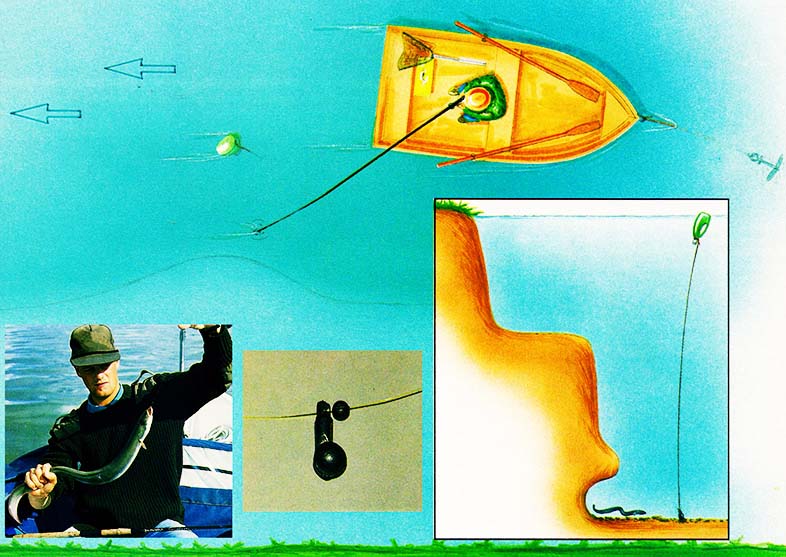 W czerwcu, gdy wylęg ryb spokojnego żeru jest bardzo łatwą zdobyczą, węgorze stają się niezwykle żarłoczne. W okresie tym najskuteczniejszą przynętą są maleńkie rybki. Autor jest zwolennikiem łowienia w rzece w pobliżu podmytych brzegów.
W czerwcu, gdy wylęg ryb spokojnego żeru jest bardzo łatwą zdobyczą, węgorze stają się niezwykle żarłoczne. W okresie tym najskuteczniejszą przynętą są maleńkie rybki. Autor jest zwolennikiem łowienia w rzece w pobliżu podmytych brzegów.
Przy ładnej pogodzie w czerwcu woda szybko ogrzewa się do temperatury około 20 stopni. Świadomość, że węgorze zaczęły już intensywnie polować na wylęg ryb spokojnego żeru, sprawia, że nie mogę spokojnie usiedzieć w domu. W miesiącu tym rokrocznie łowię grube węgorze i to nawet w biały dzień. Cała sztuka polega głównie na odpowiednim wytypowaniu łowiska w rzece. Zawsze zwracam więc baczną uwagę, gdzie rybacy stawiają sieci. Wczesną wiosną nietrudno zauważyć. że rybacy stawiają bardzo dużo żaków na węgorze i to przeważnie w głębokich miejscach. W bezpośrednim sąsiedztwie sieci wędkować oczywiście nie wolno, nie mniej jednak jest to bardzo cenna wskazówka, gdzie znajdują się najlepsze łowiska węgorzy. Jeżeli miałbym w kilku słowach opisać takie łowisko, to powiedziałbym. że jest to głęboki ciemny dół u podstawy stromych spadków dna lub w pobliżu podmytych brzegów. W sezonie miejsca takie znajduję zarówno dzięki rybakom, jak i za pomocą echosondy. Najczęściej prąd wody podmywa brzegi tak bardzo, że u ich podstawy tworzą się naturalne „nawisy”, pod którymi chętnie chowają się węgorze.
Dno z małżami
W miejscach takich dno jest zazwyczaj bardzo twarde i raczej pozbawione roślinności wodnej. Często występują tam natomiast spore ławice słodkowodnych małży. Ciemne dziury o głębokości około pięciu metrów są idealnymi łowiskami grubych węgorzy (także w dzień). Po znalezieniu odpowiedniego miejsca nęcę je przynajmniej dzień wcześniej przed rozpoczęciem właściwego wędkowania. Zanętą podstawową jest „papka” z kawałków świeżych ryb spokojnego żeru złowionych na wędkę. Po dodaniu gliny i środka wiążącego, zanęta nabiera odpowiedniej konsystencji i daje się formować w dowolnej wielkości kule. Jestem przekonany, że nęcenie znacznie poprawia wyniki w łowieniu węgorzy.
Oznaczanie łowiska
Odnalezienie na drugi dzień zanęconego miejsca jest możliwe tylko po uprzednim oznakowaniu. Najlepiej do tego celu nadaje się zwykła plastykowa butelka. Przywiązuję ją do sznurka. a do drugiego końca sznurka przywiązuję duży ciężarek. Bojkę sygnalizacyjną stawiam tak, aby była zatopiona kilka centymetrów pod powierzchnią wody. Przystępując do łowienia zawsze dokładnie wiem, gdzie znajduje się zanęcone miejsce. Przedtem jednak zamieniam butelkę na dobrze widoczną małą bojkę w pomarańczowym kolorze. Dzięki temu mam później doskonały punkt odniesienia podczas kotwiczenia łodzi. Precyzyjne zakotwiczenie się jest bardzo ważne, gdyż zazwyczaj łowię przez cały dzień tylko z jednego miejsca. Jeżeli nastawiam się na połów dużych węgorzy, używam dość wytrzymałego kija o bardzo czułej szczytówce. Wędzisko to musi mieć przynajmniej 2,10 m długości. Ciężarek nie powinien być zbyt duży. gdyż podczas wędkowania z łodzi nie potrzeba wykonywać dalekich rzutów. Poza tym, używając lekkiego ciężarka mogę przymocować go znacznie bliżej haczyka (w odległości około 25 cm), dzięki czemu lekko falująca w wodzie przynęta ciągle będzie utrzymywać się nad dnem. Po kilku eksperymentach najbardziej praktyczny okazał się mały, samodzielnie odlewany ciężarek bez karabińczyka (patrz zdjęcie z lewej na dole). Haczyk także musi być bardzo starannie wybrany. Mnie na przykład najbardziej przypadł do gustu haczyk gamakatsu nr 2 z długim trzonkiem. Ten superostry haczyk od razu wbija się w pysk lub przełyk ryby. Poza tym haczyk ten jest wykonany z cienkiego drutu, co bardzo ułatwia zakładanie przynęty, czyli dwóch lub trzech maleńkich martwych rybek. Nie zapominajmy, że na początku lata węgorze zawzięcie polują głównie na wylęg ryb spokojnego żeru.
Szczytówka sygnalizatorem brań
Jeżeli łowimy sami i na dodatek jeszcze na dwie wędki, najważniejsza jest ciągła koncentracja. Brania sygnalizowane są drganiami szczytówki wędziska. Kabłąk kołowrotka jest zamknięty, hamulec mocno dokręcony. W momencie brania chwytamy wędkę do ręki i jak najszybciej luzujemy żyłkę poprzez zanurzenie szczytówki w wodzie. Dzięki temu węgorz ma około 40 cm pola manewru i nie czuje podejrzanego oporu. W chwilę po popuszczeniu żyłki wykonujemy zacięcie. Czasami zamiast oczekiwanego węgorza może wziąć nam na przykład sandacz.
Dzięki szybkiemu zacięciu prawie wszystkie ryby są zahaczane za sam koniec pyska, a to z kolei bardzo ułatwia uwalnianie haczyka.
Podczas moich wypraw na węgorze wielokrotnie testowałem skuteczność różnych substancji smakowo-zapachowych. Niestety bez wyraźnych efektów. Uważam więc, że naturalny zapach pokrojonych na kawałeczki ryb spokojnego żeru jest najlepszym atraktorem na węgorze. I jeszcze jedno – z własnego doświadczenia wiem, że na najlepsze brania można liczyć tylko w wodzie płynącej. W wodzie stojącej bardzo korzystne są więc prądy głębinowe tworzące się dzięki wiatrowi. W rzece brania węgorza należy spodziewać się w każdej chwili.